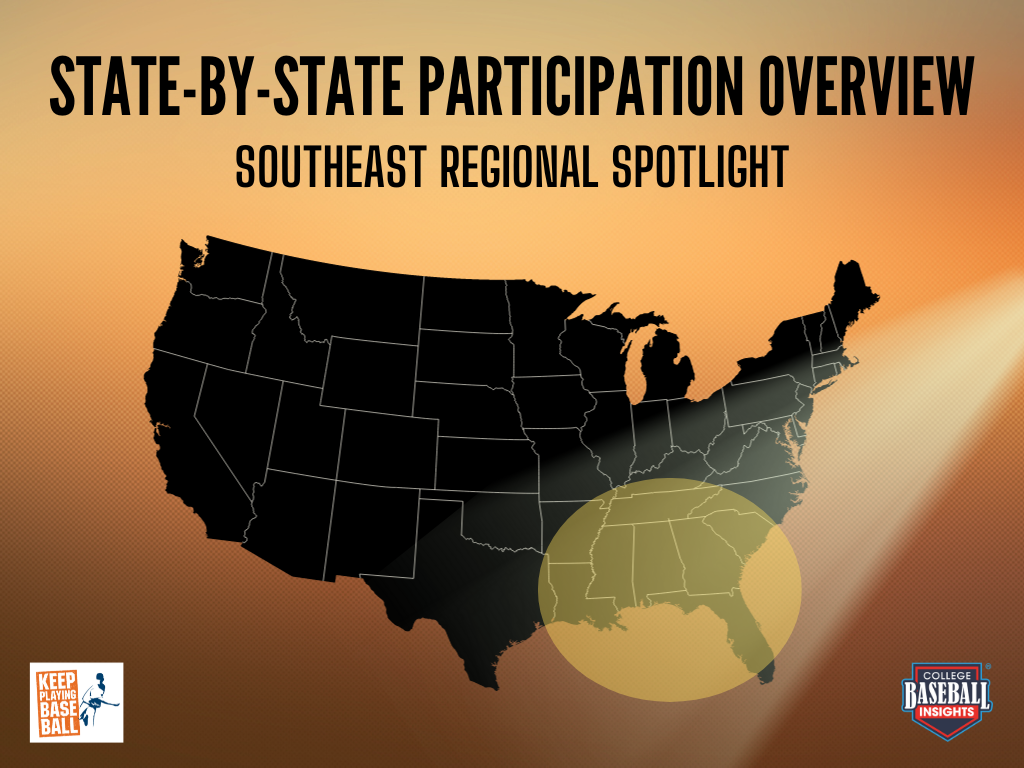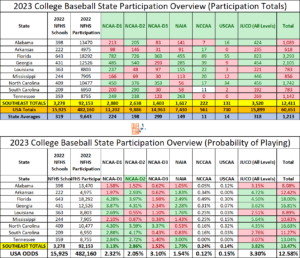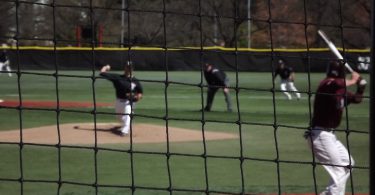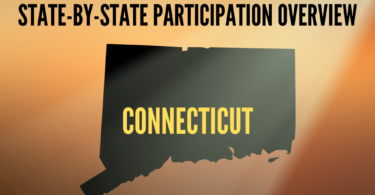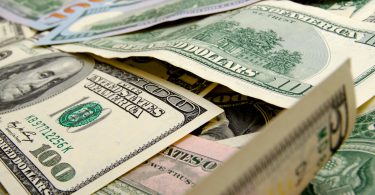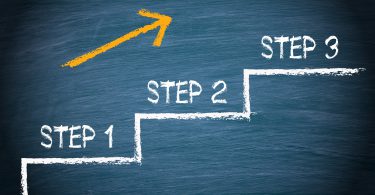You’re interested in playing college baseball, but what are your chances of making it to the next level? While many tout national probability as gospel, it turns out your odds of playing at the next level vary greatly depending on where you live.
If you live in the Southeast region and are wondering what percentage of high school graduates from your state play at each college level and where they are playing, you’ve come to the right place. In this article, we team up with our friends at College Baseball Insights to provide you with state-level overview of your chances to play at the next level.
For each of our Southeast states below, we break down:
- High school baseball participation by state
- Number of HS graduates from each state participating at each level of college baseball
- The odds of playing at each level of college baseball for high school graduates from every state
- An overview of player participation trends compared to the national and regional averages
You can see an overview of our resources, methodology, and limitations on our College Baseball Participation Overview Main Page.
Southeast Region Overview
With 92,153 high school baseball participants, the Southeast region is the 2nd most populated of our 7 regions, trailing only the Midwest region. The Southeast states account for 19.1% of all NFHS high school baseball players nation-wide but graduates from these states make up over 20.5% of all college baseball participants. The probability of players from the Southeast Region moving on to play college baseball at any level (13.47%) is above the national average (12.58%). The Southeasts overall college baseball probability is the 4th best out of the 7 regions, the last of the regions north of the national mark. Unlike some regions, which show relatively similar trends across states, the Southeast has good, great, and poor states at moving players to the next level.
The Southeast builds its above average college baseball pipeline through consistently solid numbers across the board. While the numbers are solid across 4 of the 5 major levels, the Southeast doesn’t dominate at any single level the way more successful regions do (D3 in the Northeast or JUCO in the West, for example). The Southeast ranks 1st in D2 (2.86%), 2nd in D1 (3.13%), 3rd in JUCO (3.82%), and 4th in NAIA (1.75%) participation rates among the 7 regions. You’ll notice by looking at the charts below that even at levels where it ranks in the top among different regions, the totals are not too far ahead of the national average. For D2, where Southeast Region is king, it’s still only .81 percentage points above the national average and only .44 percentage points above the second-best region. The same is true for its 2nd best D1 mark. It should be noted that the Southeast is tops of any region in sending players to the NCCAA level (0.24% and 222 total participants).
The D3 level (1.52%) is the only major level of college baseball where the southeast participation rates are below the national average. At the D3 level, the region is tied for last with the Southwest region at 1.52% participation rate.
The Southeast is considered a baseball hotbed and it’s a region where college baseball fandom peaks in the United States. With a mix of success among states from the Southeast, a closer look at state-by-state overviews is likely to prove most helpful in determining whether the region lives up to its college baseball reputation.
You can see the complete breakdown of the Southeast Region below, where boxes in green are above the national averages and boxes highlighted in red are below the national averages. Due to small overall participation numbers, we did not color code probability boxes for the NCCAA and USCAA levels.
Regional Comparison
Below, you can see how the Southeast matches up against other regions from around the country.
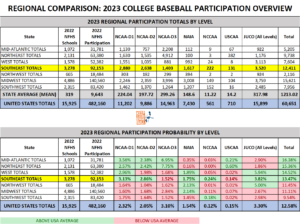
Below we provide an advanced breakdown of each state (listed in alphabetical order). To read the complete article on each state, simply click on the state name!
Alabama
It may surprise you to find out that Alabama has the 2nd most high school baseball participants of any state in the region, trailing only Florida. It’s 13,470 high school baseball participants are comparable to New Jersey’s totals, but that’s where the similarities stop. Alabama is below national and regional averages in every college baseball level. Alabama’s JUCO participation percentage (3.15%) is the closest level to matching the national average for that level (3.30%). This is due in large part to having 20 in-state JUCO options, the 6th most among all states. Every other level falls well below average, resulting in a low 8.08% overall college baseball participation rate. Despite 10 in-state D1 programs, Alabama only sends 1.58% of its players to that level. That’s the lowest mark in the region. There are 7 in-state D2 options, but only a 1.52% D2 participation rate. NAIA (1.05%) and D3 (0.62%) are worse off than the previously mentioned levels. With lots of high school participation and 44 in-state college options across all levels, it’s a big surprising how low the state of Alabama ranks.
Arkansas
Arkansas’ 4,975 high school baseball participants are the fewest of any state in the Southeast region but 30 total in-state college baseball opportunities help the state’s 12.42% overall college baseball participaiton rate hover close to the national (12.58%) and regional (13.47%) averages. Arkansas is above both national and regional averages for the D2 (2.93%), NAIA (1.83%), and JUCO (4.72%) levels. That’s good for 5th, 4th, and 2nd best among the 9 states in the region, respectively. Arkansas also ranks 2nd regionally for the NCCAA level at 0.34%. For the D1 (1.97%) and D3 (0.62%) levels, participation rates fall below national and regional averages. Those rates are the 2nd and 3rd worst in the region, respectively. As previously mentioned, the 5 D1, 7 D2, 3 D3, 5 NAIA, and 8 JUCO’s in-state provide good options for a relatively small playing population.
Florida
Florida unsurprisingly plays host to the biggest high school baseball population in the Southeast with 18,292 participants. That’s roughly 5,000 more high school players than Alabama, who has the second most participants in the region. Florida is often talked about as a hotbed for baseball, and rightfully so. The state’s overall college baseball participation of 18% is well above the national (12.58%) and regional (13.47%) averages, and sets the pace for the Southeast. Not only is it the best overall participation rate in the region, it’s good for 5th best in the country. In other words, Florida is living up to its reputation.
Interestingly, Florida has created the best college baseball pipeline in the region despite not being tops in the southeast for any level of college baseball. In spite of no major standout level, Florida is consistently well-above average for every level except D3, where its 1.98% participation rate falls below the national average (3.10%) and a bit above the struggling regional average (1.52%). The D3 rate is actually surprisingly high, given there are no D3 options in-state and surrounding states aren’t much better.
You’ll notice below that Florida’s successful D1 (4.28%, 2nd in region), D2 (3.97%, 3rd in region), NAIA (2.49%, 2nd in region), and JUCO (4.50%, 2nd in region) participation rates are solidly above the national and regional averages. For the smaller Christian-based levels, NCCAA and USCAA, Florida’s respective 0.49% and 0.30% participation rates are good for 1st and 2nd best in the region.
With 13 D1, 14 D2, 8 NAIA, 23 JUCO, 3 NCCAA, and 1 USCAA programs in-state, Florida players have plenty of places to play after college. The sunshine state, notorious for year-round baseball weather, is also a heavily recruited state for programs from all over the country.
Georgia
Georgia’s 16.81% college baseball participation rate is the second best in the region, trailing Florida by a little over a percentage point. Nationally, Georgia stacks up well sending more than 4% more of its players to college baseball than the national average of 12.58%. Georgia is above national and regional averages at the D1 (3.87%, 3rd in region), NAIA (2.28%, third in the region), and D2 (4.31%, 1st in region) levels. If Georgia’s D2 participation rate seems high, it’s because it is. 4.31% is the second best D2 participation rate of any state. Georgia is also above the national average for the JUCO level (3.62%), even though it falls short of the regional average of 3.82%. While Georgia’s 2.34% D3 participation rate is also tops in the region, that mark falls below the national average of 3.10%. Georgia emerging as strong state for sending players to the college level should come as no surprise to those who are familiar with the quality of high school baseball in the Atlanta Metro Area, let alone the rest of the state. The Peach State’s high school players also benefits from strong in-state college options across divisions. There are 6 D1, 14 D2, 6 D3, 7 NAIA, 6 JUCO, and 2 NCCAA programs totaling 41 college baseball options for Georgia graduates. Georgia’s 14 D2 programs is tied with Florida for the 3rd most of any state in the country. The NCCAA programs translate to a .31% participation rate at that level, which is the third best of the region.
Louisiana
While the state of Louisiana may have a few College World Series championships under its belt, it’s 8.89% overall college baseball participation rate is the second lowest in the region and well below the national average of 12.58%. The state’s 2.69% D1 participation rate is above the national average, but good for only 7th in the region. The NAIA (1.76%, 5th in the region) is the only level where Louisiana is above both the national and regional averages. Louisiana is below national and regional averages for D2 (0.55%, last in region), D3 (1.10%, 5th in the region), and JUCO (2.51%, last in the region). With 12 D1, zero D2, 1 D3, 7 NAIA, and 5 JUCO programs in-state, it’s easy to see why the state doesn’t do better job of moving more of its nearly 9,000 high school participants to the next level. Like everywhere, the players follow the opportunity and its unsurprising to find out that the levels where the most opportunity exists (D1 and NAIA) are the levels where it does best.
Mississippi
Mississippi’s 10.83% overall college baseball participation rate is below national and regional averages, and the 3rd lowest of the region. The Magnolia state leaps over both Louisiana and Alabama because of its success at sending players to the JUCO level. More than half of Mississippi’s ballplayers in college are playing at the JUCO level. The 5.64 JUCO participation rate is tops in the region and 6th best nationally. Unfortunately, every other level is below both national and regional averages. D1 (2.10%, 3rd lowest of region), D2 (.87%, 2nd lowest of region), D3 (.38%, lowest of the region), and NAIA (1.43%, 5th best of region) levels are all very low. The state has 6 D1, 2 D2, 2 D3, 4 NAIA, and 15 JUCO options at the college level. The 31 total programs (and especially 15 JUCO options) are a decent number of options for a state that has less than 8,000 high school participants.
North Carolina
North Carolina is another Southeastern state that is helping to bring up the regional averages. It’s overall college baseball participation rate of 16.63% is good for 3rd in the region, right behind Georgia and well above the national average of 12.58%. As a bordering state with the Mid-Atlantic region to its north, it’s interesting that North Carolina seems to have some influence from its Mid-Atlantic neighbors. The Tar Heel state is best in the Southeast Region at sending players to the D3 level (3.37%). While that rate would be last in the Mid-Atlantic, it’s far superior to the dismal probability of the southeast (1.52%). In fact, only one other state has a D3 participation rate above 2%. North Carolina is also above regional and national averages for the D1 (4.3%, 1st in the region), D2 (3.59, 4th in the region), and JUCO (4.35%, 4th in region) levels. It rounds out its strong levels by being the top state in the region at sending players to the USCAA level (.32%, 1st in region). At the NAIA level, North Carolina is dead last in the region and well-below national average with a 0.53% participation rate.
North Carolina’s solid baseball pipeline tothe majority of college baseball levels isn’t surprising given its proximity to states with great baseball options. Players wanting to stay in-state also have 52 college programs to explore. The state has 18 D1, 9 D2, 7 D3, 2 NAIA, and 14 JUCO programs. Most states with comparable high school participation have far fewer in-state options.
Tennessee
Tennessee’s 13.04% overall college baseball participation rate gives it the 5th best mark in the Southeast Region. That’s above the national average (12.58%) but below the regional mark. Tennessee’s only major level that is above both the national and regional averages is the NAIA. Tennessee’s 3.0% NAIA participation rate is best in the region and nearly double the national average. The Volunteer State is better than the national average for the D1 and D2 levels, sending a respective 2.84% and 2.72% of players on to participate at each level. That’s good for only 6th and 7th best in the nine-state region, which is a testament to the southeast’s ability to move players to the D1 and D2 ranks as a whole. Despite being below regional and national averages, Tennessee’s 1.4% participation rate for the D3 level ranks 4th best in the southeast, showing how poorly a job the southeast does at getting kids to the D3 level. Rounding out the major levels, Tennessee sends 3.07% of high school participants on to the JUCO ranks, which is the 3rd lowest total in the region. Interestingly, the state has no NCCAA or USCAA participation at all.
In Tennessee, there are 10 D1 programs, 10 D2 programs, 3 D3 programs, 8 NAIA programs, and 10 JUCO options. When compared with Louisiana, who has a similar number of high school baseball participants but only 25 college baseball programs in state, the 41 in state options in Tennessee helps explain why the overall participation rate is so much higher.
South Carolina
South Carolina has the 2nd fewest high school baseball participants of any state in the Southeast with just under 7,000. Overall, the Palmetto State moves players on to the next level at a 11.27% rate. This is below both the national and regional average by more than 1% points. The D2 level is where South Carolina has the strongest pipeline. 4.17% of South Carolinians move on to play at the D2 level, surpassing the regional (2.86%) and national (2.05%) averages by a good amount. That’s good enough for 2nd best in the region. The state’s 2.88% rate of sending players to the D1 level is above the national average (2.32%) and the 5th best mark in the southeast. South Carolina struggles with every other major level. It’s 2.76% JUCO participation rate is 2nd worst in the region, as are the dismal 0.43% D3 and 0.83% NAIA participation rates. As we’ve seen playing out in our regional overviews, the participation rates often mirror the in-state playing opportunities. The Palmetto state has the best numbers where the most programs exist. 13 D2 and 10 D1 programs are joined by only 3 NAIA and 6 JUCO programs. There are no D3 options in-state.
Limitations
This article was written with data and insights from 3rd party sources, College Baseball Insights and NFHS High School Participation Data. Data and insights are subject to revision and/or change. We’ve attempted to display as accurate a picture as possible with the information that is available. Readers should be aware that college baseball roster data is fluid and changes throughout the year. Every attempt is made to reconcile data and keep up with changes, but this article may not reflect the changes or updates from 3rd parties. Insights cannot account for gap year programs, misreported roster information, or other inaccuracies which may slightly alter the numbers and percentages used in this article. Insights are subject to change and are based on best available information.

